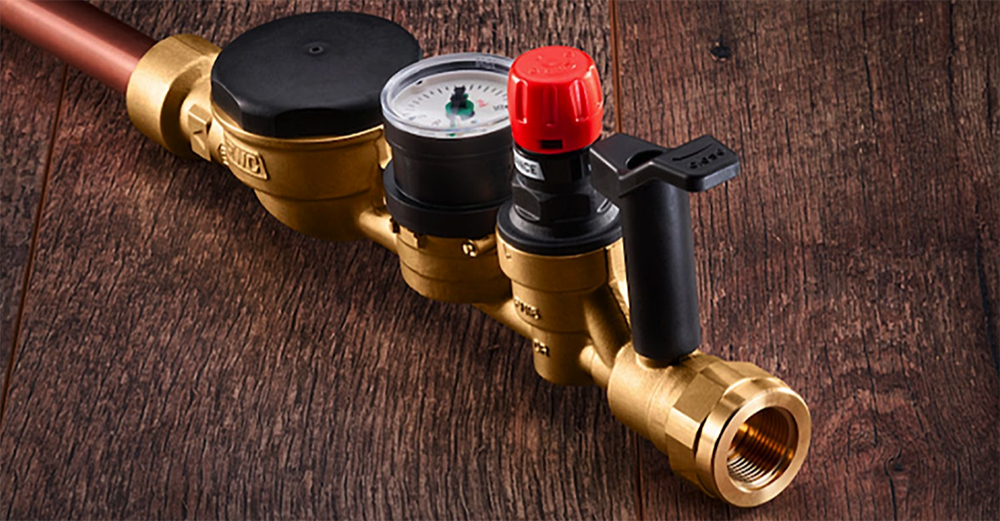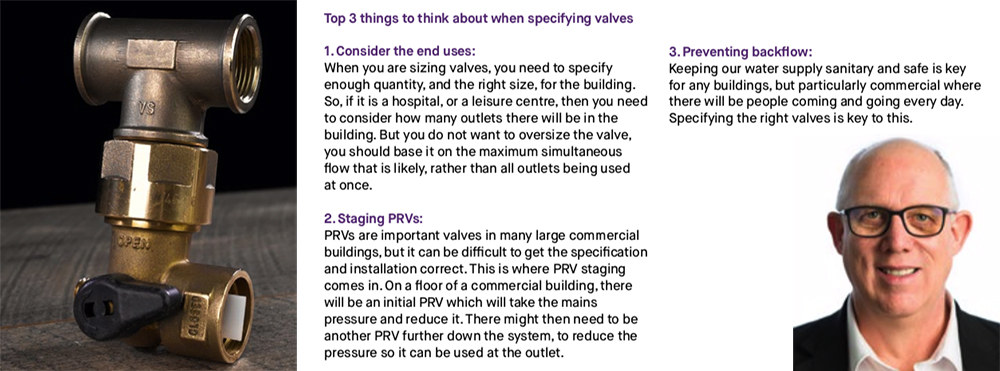Specifying valves for large commercial buildings
[edit] A go-to-guide for specifying valves for large commercial buildings
From the plant room to the appliances and outlets, there is a lot that goes into creating a specification for a plumbing system in large commercial buildings. Valves are an important, but often overlooked, part of this puzzle. Eric shares his advice on everything that a specifier needs to know when working on plans for large commercial buildings.
When planning the plumbing system for a large commercial building, there is a lot that specifiers will need to consider including the demands for each building, complying to all necessary regulations, and any maintenance requirements.
Then there is also the challenge many specifiers are facing, which is making our buildings more energy efficient and economical in the long term. All these factors will play an important role when specifying the right plumbing fixtures and fittings that will be needed, including the valves.
From leisure centres to hospitals to schools and high- rise apartments, here is your guide on specifying valves for large commercial buildings.
[edit] From PRVs to TMVs, six valves to consider in your specification
When working on a commercial property, there are many valves that you will come across that are also used in a domestic setting. These include pressure reducing valves (PRVs) and thermostatic mixing valves (TMVs), but there are also valves that are designed specifically for large multi-occupancy buildings, like the Tenant Valve. Here are the most common valves you should consider in your next specification:
[edit] Pressure reducing valves (PRVs)
These valves work by reducing a high inlet pressure to a safer, lower pressure at the outlet. Water pressure in the UK can vary from 1 bar to 20 bar, so PRVs are important to ensure the risk to plumbing systems is minimised. In large commercial buildings, high pressure is often needed to allow for water to travel around the systems, but this pressure would damage outlets so PRVs are needed to reduce the pressure at point of use.
[edit] Thermostatic mixing valves (TMVs)
Whatever hot water system you are planning, TMVs are key to ensuring the water is kept at a safe temperature to prevent scalding while also allowing the system to be kept at a high enough temperature to help prevent the build-up of harmful Legionella bacteria. In most commercial buildings, TMV2 approved valves need to be specified, but for buildings in the healthcare sector like hospitals, a TMV3 approved valve is required.
[edit] Tenant Valves
Designed specifically for use in large commercial buildings like apartment complexes, it combines an isolating valve, approved as a stop valve, a PRV, with an integral strainer, a patented dual reading pressure gauge, water meter carrier and a double check valve in one small and compact unit.
[edit] Thermal balancing valves (TBVs)
These valves regulate the flow rates in hot water systems depending on the temperature, to ensure that a balanced water temperature is available when and where it is needed throughout the building. It is important to maintain a consistent temperature in a circuit, as balancing the water temperature prevents Legionella growth and helps avoid heat spikes that could damage other plumbing components or cause scalding.
[edit] Backflow prevention valves
To keep our water supply sanitary and safe, it is important that backflow is prevented. These valves help by protecting plumbing systems from contamination, from either back pressure, or back siphonage.
[edit] Ball valves (isolation)
In a large building, there will be situations where the water supply to fixtures needs to be isolated to allow for repair and maintenance. Ball valves allow this work to be done quickly and easily.
When you are specifying valves for commercial buildings, it is particularly important that you have a thermal balancing valve. In larger systems, hot water is always circulating, because the point of use is often a long way from where the hot water is stored. So, without this the end user may have a long wait for their hot water, and areas of the building can become stagnant leading to a higher risk of bacteria developing in the water system. But this circulation needs to be controlled, which is where thermal balancing valves come in.
[edit] Hospitals to high rises – the varying valves by usage
When you are working on large commercial buildings, for the most part, you will need to specify the same valves regardless of building use. However, there are a few exceptions. When you are specifying a hospital or a healthcare building, you will need to specify TMVs that are compliant with the TMV3 scheme.
In healthcare settings, it is also important that you specify Anti-Legionella valves. These valves that connect to an expansion vessel prevent stagnation. This also helps to prevent Legionella growth, so you need to specify the valves in buildings occupied by people more vulnerable to Legionella.
The other building types that you need to consider specific valves for are high-rise buildings. In these properties, you will likely need to specify PRVs. This is because you need high-water pressure at the bottom of the building, so it can make it to the top. For example, if you start at 15-16 bar, you are going to get 2-3 bars at the top of the building. But this means on the lower levels, you need to have good pressure control, so you do not damage the infrastructure of the building.
[edit] Regulations to remember
When you are specifying valves in large commercial buildings, the products need to comply with water regulations. This means they need to be WRAS, KIWA or REG4 approved. For pressure reducing valves or backflow prevention valves, these need to comply with European and British Standards, for the pressure reducing valve this is BSEN1567.
For commercial buildings, it is also recommended that you comply with either the TMV2 or TMV3 schemes depending on the property usage. For most commercial buildings, like leisure centres or schools, it is best practice to follow the guidance set out in the TMV2 scheme. This sets out the standard for the installation, commissioning, and maintenance on TMVs.
The requirements for the TMV3 scheme are higher than TMV2, as it is designed to regulate valves for use in healthcare. These valves differ as they go through extra testing to ensure performance based on the NHS’s HTM64 -D08 specification. This specification includes a requirement for valves to maintain constant water temperature, irrespective of varying hot and cold water supply conditions, and to fail-safe in the event of an interruption in either the hot or cold water supplies.
[edit] Installation considerations to bear in mind
When you are specifying any building, no matter how large or small, you need to consider whether the valves need to be serviced, any ongoing maintenance requirements needed on the surrounding pipework.
For valves that need to be serviceable, it is best practice to also include an isolation valve so the product can be serviced easily. For valves that include an integral strainer, this will need periodic maintenance.
You also need to consider the related pipework you need for the plumbing and heating system. In the case of a PRV, it is recommended that you have five times the pipe diameter both upstream and downstream of the valve, so if you have a 2-inch valve you should have a 10-inch straight line before any elbows to stop noise. You also need to make sure you size your valves correctly to reduce noise. For example, it is best not to put a 2-inch valve where a flow rate of a 1-inch valve can do.
For PRVs, specifying the right valve is particularly key, as you need to consider the pressure reduction ratio. It
is generally a 10 to 1 ratio, so a 16 bar inlet pressure can reduce to 1.6 bar. You also need to correctly size a PRV to suit the flow rate of the water pressure passing through it, not the inlet pipe size, as this can lead to over-sizing. This can have adverse effects on the system, such as undesired noise and damage to the PRV seat.
This article appears in the AT Journal issue 165, summer 2023 as "Your go-to-guide for specifying valves for large commercial buildings" and was written by Eric Winter, EMEA Director of Product Development (Valves), RWC. Pictured above.
--CIAT
[edit] Related articles on Designing Buildings
- Actuator.
- A guide to installing thermostatic mixing valves: what, why and how.
- BSRIA announces 2021 European HVAC field device study.
- BSRIA publishes new edition of BG29.
- BSRIA study: The market for European Field Devices.
- Closed Systems Control Association.
- Control valve.
- Differential pressure control valve.
- Float valve.
- Gasket.
- Mechanical, electrical and plumbing MEP.
- Pipework.
- Pipework defects, ventilation and airflow rates.
- Pressure independent control valves.
- Pressure-relief valve.
- Stop valve.
- Tap.
- Thermostatic mixing valve.
- Types of valve.
- Valves.
- Water hammer.
- What makes a good PICV?
Featured articles and news
Grenfell Tower Principal Contractor Award notice
Tower repair and maintenance contractor announced as demolition contractor.
Passivhaus social homes benefit from heat pump service
Sixteen new homes designed and built to achieve Passivhaus constructed in Dumfries & Galloway.
CABE Publishes Results of 2025 Building Control Survey
Concern over lack of understanding of how roles have changed since the introduction of the BSA 2022.
British Architectural Sculpture 1851-1951
A rich heritage of decorative and figurative sculpture. Book review.
A programme to tackle the lack of diversity.
Independent Building Control review panel
Five members of the newly established, Grenfell Tower Inquiry recommended, panel appointed.
Welsh Recharging Electrical Skills Charter progresses
ECA progressing on the ‘asks’ of the Recharging Electrical Skills Charter at the Senedd in Wales.
A brief history from 1890s to 2020s.
CIOB and CORBON combine forces
To elevate professional standards in Nigeria’s construction industry.
Amendment to the GB Energy Bill welcomed by ECA
Move prevents nationally-owned energy company from investing in solar panels produced by modern slavery.
Gregor Harvie argues that AI is state-sanctioned theft of IP.
Heat pumps, vehicle chargers and heating appliances must be sold with smart functionality.
Experimental AI housing target help for councils
Experimental AI could help councils meet housing targets by digitising records.
New-style degrees set for reformed ARB accreditation
Following the ARB Tomorrow's Architects competency outcomes for Architects.
BSRIA Occupant Wellbeing survey BOW
Occupant satisfaction and wellbeing tool inc. physical environment, indoor facilities, functionality and accessibility.
Preserving, waterproofing and decorating buildings.



























